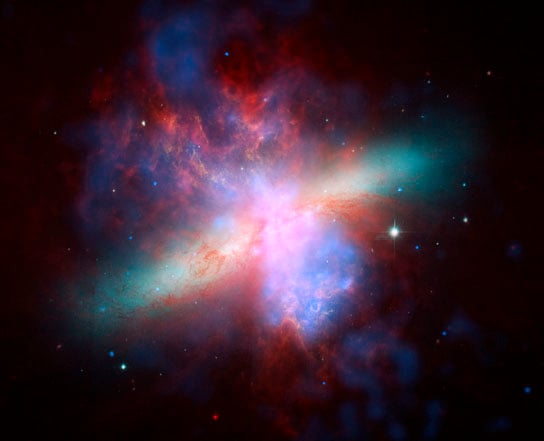
Images from three of NASA’s Great Observatories were combined to create this spectacular, multiwavelength view of the starburst galaxy M82. Optical light from stars (yellow-green/Hubble Space Telescope) shows the disk of a modest-sized, apparently normal galaxy. Another Hubble observation designed to image 10,000 degrees Celsius (18,000 degrees Fahrenheit) hydrogen gas (orange) reveals a startlingly different picture of matter blasting out of the galaxy. The Spitzer Space Telescope infrared image (red) shows that cool gas and dust are also being ejected. Chandra’s X-ray image (blue) reveals gas heated to millions of degrees by the violent outflow, which can be traced back to vigorous star formation in the central regions of the galaxy. The burst of star formation is thought to have been initiated by a close encounter with a large nearby galaxy, M81, about 100 million years ago. Credit: X-ray: NASA/CXC/JHU/D.Strickland; Optical: NASA/ESA/STScI/AURA/The Hubble Heritage Team; IR: NASA/JPL-Caltech/Univ. of AZ/C. Engelbracht
Using optical morphologies from the Hubble Space Telescope and infrared photometry from the Wide-field Infrared Survey Explorer, a team of astronomers found 29 objects with outflowing winds measuring up to 2,500 kilometers per second.
Fierce galactic winds powered by an intense burst of star formation may blow gas right out of massive galaxies, shutting down their ability to make new stars.
Sifting through images and data from three telescopes, a team of astronomers found 29 objects with outflowing winds measuring up to 2,500 kilometers (1,550 miles) per second, an order of magnitude faster than most observed galactic winds.
“They’re nearly blowing themselves apart,” said Aleksandar Diamond-Stanic, a fellow at the University of California’s Southern California Center for Galaxy Evolution, who led the study. “Most galactic winds are more like fountains; the outflowing gas will fall back onto the galaxies. With the high-velocity winds we’ve observed the outflowing gas will escape the galaxy and never return.” Diamond-Stanic and colleagues published their findings in Astrophysical Journal Letters.
The galaxies they observed are a few billion light years away with outflowing winds of 500 to 2,500 kilometers (310 to 1,550 miles) per second. Initially, they thought the winds might be coming from quasars, but a closer look revealed these winds emanate from entire galaxies.
Young, bright, and compact, these massive galaxies are in the midst of or just completing a period of star formation as intense as anyone has ever observed.
“These galactic-scale crazy-fast winds are probably driven by the really massive stars exploding and pushing out the gas around them,” said Alison Coil, professor in UC San Diego’s Center for Astrophysics and Space Sciences and a co-author of the paper. “There’s just such a high density of those stars it’s like all these bombs went off near each other at the same time. Each bomb evacuates the area around it, then the next can push gas out further until they’re evacuating gas on the scale of the whole galaxy.”
Galaxies with winds this fast are also quite rare, opening up the question of whether these are unusual events or part of a common phase in the evolution of massive galaxies that is seldom observed because it is so brief.
Astrophysicists still lack an explanation for how and why star making ends. Theorists who model the evolution of galaxies often invoke supermassive black holes called active galactic nuclei, which can also generate savage winds, to explain how gas needed to form stars can be depleted.
These new observations demonstrate that black holes may not be necessary to account for how these kinds of galaxies run out of gas. “The winds seem to be powered by the starburst,” Diamond-Stanic said. “The central supermassive black hole is apparently just a spectator for these massive stellar fireworks.”
Reference: “High-Velocity Outflows Without Agn Feedback: Eddington-Limited Star Formation in Compact Massive Galaxies” by Aleksandar M. Diamond-Stanic, John Moustakas, Christy A. Tremonti, Alison L. Coil, Ryan C. Hickox, Aday R. Robaina, Gregory H. Rudnick and Paul H. Sell, 1 August 2012, Astrophysical Journal Letters.
DOI: 10.1088/2041-8205/755/2/L26









Be the first to comment on "High-Velocity Galactic Winds Moving at 2,500 Kilometers Per Second"